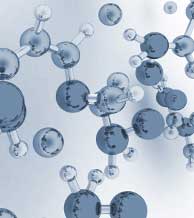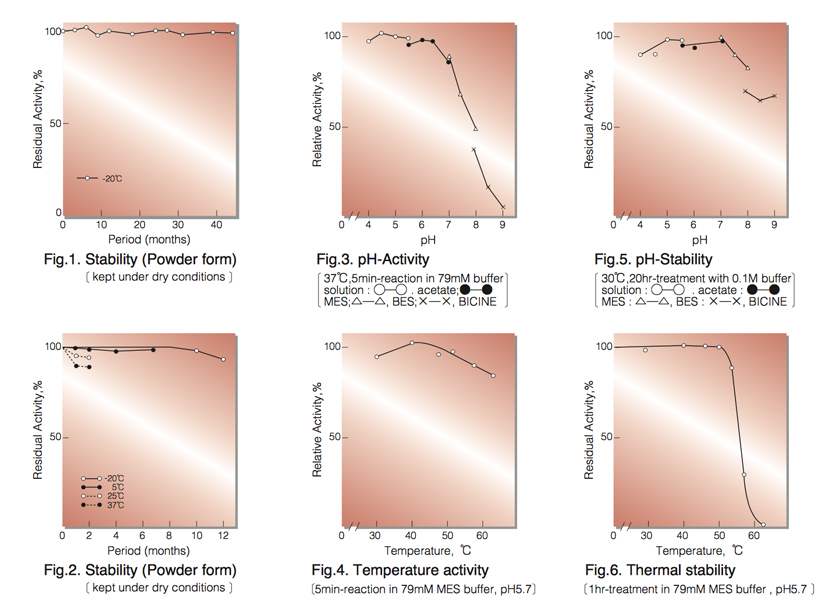GLUCOSE OXIDASE from Aspergillus sp.
GLO-101, 201
| Appearance: | Yellowish amorphous powder, lyophilized | |
|---|---|---|
| Activity: | Grade I: 180U/mg-solid or more Grade Ⅱ: 100U/mg-solid or more (containing approx. 50% of stabilizers) |
|
| Contaminant: | Catalase Grade I ≤5.0×10⁻³% GradeⅡ ≤3.0% |
|
| Stabilizers: | Potassium gluconate, sodium glutamate | |
| Stability: | GLO-101: Stable at -20°C for at least 3 years(Fig.1) |
|---|---|
| GLO-201: Stable at -20°C for at least One year | |
| Molecular weight: | approx. 153,000 |
| Michaelis constants: | 3.3×10⁻²M (ß-D-Glucose),³ ⁾ 6.1×10⁻²M (2-Deoxyglucose) |
| Structure: | Glycoprotein with 2 moles of FAD |
| Inhibitors: | p-Chloromercuribenzoate, heavy metal ions (Cu⁺⁺, Hg⁺⁺, Ag⁺) |
| Optimum pH: | 4.5(Fig.3) |
| Optimum temperature: | 40-50℃(Fig.4) |
| pH Stability: | pH 4.5-6.0 (30℃, 20hr)(Fig.5) |
| Thermal stability: | below 50℃ (pH 5.7, 1hr)(Fig.6) |
| Substrate specificty: | (Table 1) |
| Effect of various chemicals: | (Table 2) |
APPLICATIONS⁴ ⁵⁾
This enzyme is useful for enzymatic determination of glucose, and for amylase-activity assay when coupled with
α-glucosidase (AGH-211, if maltooligosaccharide or modified starch is used as a substrate) in clinical analysis.
ASSAY
Principle:
glucose oxidase
β-D-Glucose+O₂+H₂O ►D-Glucono-δ-lactone+H₂O₂
POD
2H₂O₂+4-AA+EHSPT ►Quinoneimine dye+4H₂O
4-AA : 4-Aminoantipyrine
EHSPT : N-Ethyl-N-(2-hydroxy-3-sulfopropyl)-m-toluidine
The appearance of quinoneimine dye is measured at 555nm by spectrophotometry.
Unit definition:
One unit causes the formation of one micromole of hydrogen peroxide (half a micromole of quinoneimine dye) per
minute under the conditions described below.
Method:
| A. MES-Na buffer pH 5.7: | 0.1M [Dissolve 2.13g of 2-(N-morpholino) ethansulfonic acid (MW=213.25) in ca. 60ml of H₂O and, after adjusting the pH to 5.7 with 1N NaOH at 25°C, fill up to 100ml with H₂O](Stable at 5°C for one month) |
|---|---|
| B. Glucose solution: | 15% [Dissolve 1.5g of β-D-glucose and fill up to 10ml with H₂O]for at least 2hrs before assay.) (Should prepare fresh) |
| C. 4-AA solution: | 0.5% [50mg fo 4-aminoantipyrine (MW=203.25)/10ml of H₂O](Stable at 5°C in a brownish bottle for at least one week) |
| D. EHSPT solution: | 40mM [118mg of N-Ethyl-N-(2-hydroxy-3-sulfopropyl)-m-toluidine (MW= 295.3)/10ml of H₂O] (Stable at 5°C in a brownish bottle for at least one week) |
| E. Peroxidase solution: | 500U (purpurogalin unit)/ml of H₂O |
| F. Enzyme diluent: | 10mM MES-Na buffer, pH 5.7, containing 0.1% Triton X-100 |
Procedure
| Concentration in assay mixture | |
|---|---|
| MES buffer | 79 mM |
| D-Glucose | 131 mM |
| 4-AA | 0.2mM |
| EHSPT | 0.3mM |
| POD | ca.4 U/ml |
1. Prepare the following working solution in a brownish bottle and store on ice.
(Should be prepared fresh)
30 ml Buffer solution (A)
6 ml Substrate solution (B)
0.3 ml 4-AA solution (C)
0.3 ml EHSPT solution (D)
0.3 ml POD solution (E)
2. Pipette 3.0ml of working solution into a cuvette (d=1.0cm) and equilibrate at 37°C for about 5 minutes.
3. Add 0.1ml of the enzyme solution* and mix by gentle inversion.
4. Record the increase in optical density at 555nm against water for 2 to 3 minutes in a spectrophotometer
thermostated at 37°C, and calculate the ΔOD per minute from the initial linear portion of the curve (ΔOD test).
At the same time, measure the blank rate (ΔOD blank) by using the same method as the test except that enzyme diluent (F) is added instead of the enzyme solution.
* Dissolve the enzyme preparation in ice cold enzyme diluent (F) and dilute to 0.05-0.2U/ml with the same buffer, immediately before the assay.
Calculation
Activity can be calculated by using the following formula :

ΔOD/min (ΔOD test−ΔOD blank ) ×Vt × df
Volume activity (U/ml) = =ΔOD×1.89×df
32.8×1/2×1.0×Vs
Weight activity (U/mg)=(U/ml)×1/C
- Vt
- : Total volume (3.1ml)
- Vs
- : Sample volume (0.1ml)
- 32.8
- : Millimolar extinction coefficient of quinoneimine dye under the assay conditions (㎠/micromole)
- 1/2
- : Factor based on the fact that one mole of H₂O₂ produces a half of quinoneimine dye.
- 1.0
- : Light path length (cm)
- df
- : Dilution factor
- C
- : Enzyme concentration in dissolution (c mg/ml)
REFERENCES
- The Enzymes, Vol.XII B, P.421 (P.D.Boyer, ed.), Academic Press (1975).
- Method in Enzymology, Vol .IX, p.82 (S.P.Colowick and N.O.Kaplan, ed.),Academic Press (1966).
- B.E.P.Swoboda and V.Massay; J.Biol.Chem., 240, 2209 (1965).
- P.J.Auses, S.L.Cook and J.T.Maloy; Anal.Chem., 47, 244 (1975).
- D.C.Williams, G.F.Huff and W.R.Gaitz; Clin.Chem., 22, 372 (1976).
| Substrate (0.1M) | Relative activity(%) | Substrate (0.1M) | Relative activity(%) |
|---|---|---|---|
| D-Glucose | 100 | Fructose | 0.24 |
| 2-Dexy-D-glucose | 16.2 | Xylose | 0.93 |
| Glucono-1, 5-lactone | 0.06 | Ribose | 0.00 |
| L-Glucose | 0.00 | Maltose | 0.69 |
| Galactose | 3.10 | Lactose | 0.00 |
| Mannose | 2.10 |
| Chemical | Concn.(mM) | Residual activity(%) |
Chemical | Concn.(mM) | Residual activity(%) |
|---|---|---|---|---|---|
| None | − | 100 | NaN₃ | 20 | 96.3 |
| Metal salt | 2.0 | EDTA | 5.0 | 97.3 | |
| MgCl₂ |
92.6 | o-Phenanthroline |
2.0 | 95.3 | |
| CaCl₂ | 93.6 | α,α′-Dipyridy | 2.0 | 99.5 | |
| BaCl₂ | 94.4 | Borate | 50 | 96.1 | |
| CoCl₂ | 98.1 |
IAA | 2.0 | 96.1 |
|
| MnCl₂ | 95.1 |
NEM | 2.0 | 101.1 | |
| ZnSO₂ | 94.3 | Hydroxylamine | 10 | 98.3 | |
| FeCl₂ | 96.8 | Sodium bisulfite | 10 | 100.0 | |
| NiCl₂ | 91.7 | hydrazine | 10 | 103.1 | |
| CuSO₄ | 71.6 | Triton X-100 | 0.1% | 111.2 | |
| AgNO₃ | 58.6 |
Brij 35 | 0.1% | 108.0 | |
| HgCl₂ |
0.7 | Tween 20 | 0.1% | 110.7 | |
| PCMB | 2.0 | 31.6 | Span 20 | 0.1% | 106.7 |
| MIA | 2.0 | 96.8 | Na-Cholate | 0.1% | 106.1 |
| NaF | 2.0 | 97.1 | SDS |
0.1% | 113.1 |
PCMB, p-Chloromercuribenzoate; MIA, Monoiodoacetate; EDTA, Ethylenediamimetetraacetate; IAA, Iodoacetamide; NEM, N-Ethylmaleimide; SDS, Sodium dodecyl sulfate.

